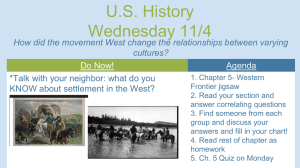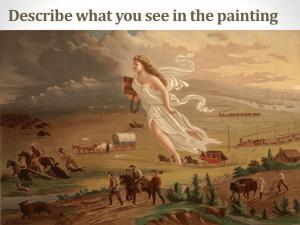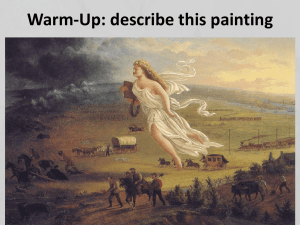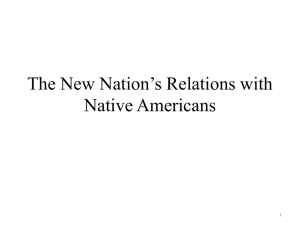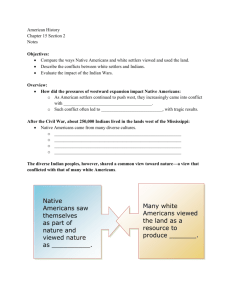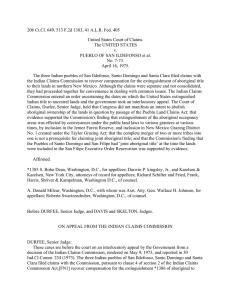ACTING AS AN AMATEUR HISTORIAN
advertisement
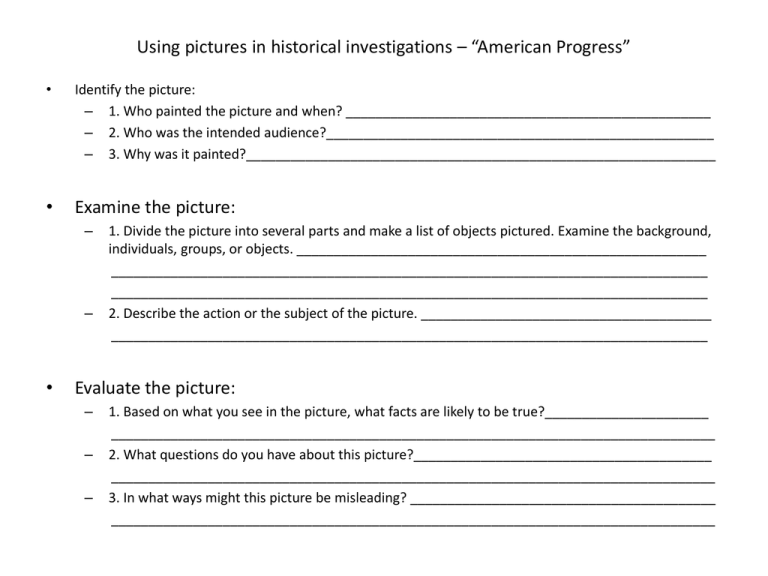
Using pictures in historical investigations – “American Progress” • Identify the picture: – 1. Who painted the picture and when? _________________________________________________ – 2. Who was the intended audience?____________________________________________________ – 3. Why was it painted?_______________________________________________________________ • Examine the picture: – – • 1. Divide the picture into several parts and make a list of objects pictured. Examine the background, individuals, groups, or objects. _______________________________________________________ ________________________________________________________________________________ ________________________________________________________________________________ 2. Describe the action or the subject of the picture. _______________________________________ ________________________________________________________________________________ Evaluate the picture: – – – 1. Based on what you see in the picture, what facts are likely to be true?______________________ _________________________________________________________________________________ 2. What questions do you have about this picture?________________________________________ _________________________________________________________________________________ 3. In what ways might this picture be misleading? _________________________________________ _________________________________________________________________________________ ACTING AS AN AMATEUR HISTORIAN When the Texas legislature was considering a bill to protect the buffalo from sharpshooters, General Philip Sheridan spoke out against the bill: “These men have done more in the last two years, and will do more in the next year, to settle the Indian question, than the entire regular army has done in the last forty years. They are destroying the Indians’ [food supply]. And it is a well known fact that an army losing its base of supplies is placed at a great disadvantage. Send them powder and lead, if you will; but for a lasting peace, let them kill, skin, and sell until all of the buffaloes are exterminated. Then your prairies can be covered with speckled cattle.” How did Sheridan feel about the slaughter of buffalo on the Great Plains? What effect did he predict if the slaughter continued? Place complete sheet in your interactive notebook. ACTING AS AN AMATEUR HISTORIAN Under the Homestead Act, the government offered public lands to settlers. This section lays out what was required for a settler to buy land: “Be it enacted, that the person applying for the benefit of this act shall register that he or she is the head of a family, or is 21 years or more, or performed service in the army, and that he has never borne arms against the U.S. government or given aid to its enemies, and that such application is made for the purpose of actual settlement and cultivation, and not either directly or indirectly for the use or benefit of another person or persons; and upon filing the said affidavit with the register, and on payment of ten dollars, he or she shall be permitted to enter the quantity of land specified.” List the requirements that a settler had to meet to settle on federal land. Place the completed sheet in your interactive notebook. Complete the graphic organizer by describing the impact of each of these developments on the settlement of the last frontier and place the completed chart in your interactive notebook: Lure of Precious Metals: The Indian Wars: Impact of Railroads:: Homestead Act: Settlement of the Far West The Cattle Industry: Farming the Great Plains: Forced Removal. In 1890 Congress ordered the removal of all Native American Indians to west of the Mississippi. Nearly one-quarter of the Cherokees perished on the journey westward known as the Trail of Tears. Flood of Settlers. Large numbers of settlers over-whelmed the Native Americans. In 1969, the Transcontinental Railroad was completed. Along with the Homestead Act, the continuation of railroad lines made Native American lands even more desirable. FACTORS ERODING NATIVE AMERICAN CONTROL OF THE WEST Warfare. The technological superiority of the U.S. government made resistance futile. The Indian Wars, which pitted settlers and federal troops against Native American Indians, lasted from 1860 – 1890. Destruction of Natural Environment. Competition between settlers, miners, and farmers for the land led to the destruction of the natural environment on which Native Americans depended for their livelihood. Threatened Tribal Ways. Assimilation threatened Native American Culture. The act encouraged individual farm ownership, opposing the tradition of sharing tribal lands. Hunters, Not Farmers. Many Native American Indian tribes had never farmed the land, since they were hunters by lifestyle and tradition. SHORTCOMINGS OF THE DAWES ACT Infertile Lands. The lands given to Native American Indians were often infertile. The government also never provided farm equipment or assistance in learning how to farm as promised. Reservation Life. These reservations often suffered from malnutrition, poverty, and untreated health problems. Reservation schools provided an inferior education. ACTING AS AN AMATEUR HISTORIAN Under the American Indian Citizenship Act of 1924, the government offered the following: “[A]ll non citizen Indians born within the territorial limits of the United States be, and they are hereby, declared to be citizens of the United States: Provided that the granting of such citizenship shall not in any manner impair or otherwise affect the right of any Indian to tribal or other property.” Imagine you are a member of a government commission in 1930. Compare the Dawes Act, American Indian Citizenship Act, and earlier policies towards Native Americans. Then decide, after balancing all of the interests involved, which policy was most effective. Which best represented Native American Indian rights? Jot down your thoughts and be prepared to make a stand for your choice. Place the completed sheet in your interactive notebook. Assignment: • Create a concept map for “Manifest Destiny”
